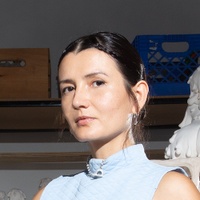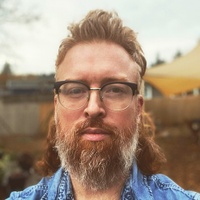As told to Eva Recinos, 2272 words.
Tags: Art, Beginnings, Process, Time management, Identity, Focus, Inspiration.
On the value of being a beginner
Visual artist Amia Yokoyama discusses experimenting with different materials, the value of time crunches, and making work that resonates.You describe your work as being a practice of world building, and I saw that you studied experimental animation at CalArts, and you also attended a school of painting and sculpture. Have you always taken a multimedia approach?
Ceramics and clay have been there on and off from the start. It was definitely one of the first art mediums I was exploring with as a kid, because my best friend growing up, her mother was a ceramicist and had a small kiln in their basement, so we would play with clay a lot as a kid, and that was a really formative experience.
I’ve always been attracted to using multiple mediums. In different moments, a certain material will become more engaging to me than others. Oftentimes it’s been controlled by what I have access to—luckily, now, I want access to a kiln, I’ve made that happen for myself. But I think that I’m the type of person where if a kiln isn’t available for whatever reason, I will just find a different way to work.
I’ve done a lot of different artist residencies. You mentioned the Skowhegan School of Painting & Sculpture, which is actually an artist residency for any type of medium. There, I was working with all sorts of materials just depending on what I was able to find. I mean, there wasn’t even an art store in town, there was a Walmart. So I was buying weird rolls of plastic from Walmart and sculpting with that. That material hasn’t solidified itself in my regular arsenal of materials that I’m drawn to, but in that moment, that’s what I had. It was just what I worked with.
I feel like as I’ve gotten older and started to be more dedicated to my art practice or had the privilege of being involved in what I want to do and how I want to work, ceramics and animation have both been ways of working that I feel like are pretty foundational to my practice at this point. Even if I do have a painting moment or I’m working with installation, ceramics and animation are two cornerstones to my material go-tos.
On the Brink, 2022-23, porcelain, stoneware, and glaze, 13.5 inches H x 17 inches W x 13 inches D
I’d love to hear a little bit more about your current process. You mentioned that having a kiln became something that you did want to have. What was that journey like, setting that up for yourself?
I was working a lot with ceramics while I was at CalArts. I was also working with stop motion animation with clay as well. I feel like people often think, “Wow, animation and ceramics are so different.” But for me it felt very in line, in the same way you talk to a friend verbally or you text them. They’re totally different forms of communicating, but it doesn’t seem like, so drastically different or something. There’s still this communication with three-dimensional space and building a world, and the softness of clay, I think, relates to the softness of a digital skin, meaning it’s not like metal where you need a heavy duty tool to make a mark on it. There’s something really responsive about clay in animation, clay and ceramics, even 3D digital animation. They don’t feel so, so different to me.
When I left school, I did a bunch of artist residencies and I was also performing a lot with my band. I was doing more animation and video and performance. Again, partially, because I no longer had access to studio space, facilities, et cetera. Occasionally, I would have some ceramics time. Sometimes I’d do performance, sometimes I’d do filmmaking. Again, residencies are very short and fast sprints of creative experimentation. Or at least the way I approach them, which was really great for me, because I love experimenting, trying new things. But I think doing two years of that was really exhausting.
When I got back to LA and got an apartment, I wanted to get back into my practice in a more grounded way. I immediately started looking for ceramics facilities, and I went to a community college and used the kiln there for a while, which was a great resource. Then through that, I got a job lab tech-ing at this community ceramics space called Clay CA, which I still work at, and work out of. That was my ceramics home for a long time.
As I started doing more shows and just getting into the material more through having access at Clay CA and at PCC (Pasadena City College), I was like, “Okay, this is something that I really want to commit to.” Then I finally got my own studio, got my own kiln and built up a studio for the first time in a long time that was not provided by residency. And that felt really great to be able to be like, “I don’t know how long it’s going to take to get this idea out, but I’m committed to it.” Whereas in a residency, it might be two months and then you’re done. You gotta pack up and leave.
Braid Blade Tree, 2022-23, porcelain, glaze, pumice stone and cast glass, 24 inches H x 18 inches W x 15 inches D
Yeah, definitely. It’s interesting to think about short time periods leading up to the feeling of: “Okay, this is what I want to be able to create over the long term as well.” But it seems like you’re also still leaving room for curiosities and experimentation, too.
Yeah, definitely. Absolutely. I think that if I lost a sense or element of experimentation, I would lose interest a lot. I’m definitely someone that’s constantly seeking out moments or little sparkles of discovery when you try something new and you discover something new that’s so exciting—and that’s a real motivating factor for me to keep seeking out different ways of working. Or just learning, in general. I feel like I’m a bit of a skills hoarder, too. I love learning a new skill. This year I started working with glass and learning how to cast glass, and mold making. I do love learning something new. And I love being a beginner at something because every step of the way is a discovery moment. Whereas when you’ve spent a lot of time with the material, you have to maybe dig deeper to find that big revelatory discovery.
Learning about your work and seeing how things like Japanese myths and pop culture and your own personal mythology come in, how do you balance doing this research and following these curiosities with just the day-to-day of your to-do list. Like, “Oh, I have to do this for the next show”? What’s that balance like?
You mean the to-do list like, do your laundry, pay your bills, kind of thing?
Yeah. And also, just the feeling of “This is an actual deadline. This is due for the next show” versus “I want to follow this curiosity, I want to research this thing.”
I have the feeling of that in my body, but how do I describe it? Yeah, I think they just all happen simultaneously. The deadlines and the to-do list are definitely an element of pressure that can sometimes help things get to where they need to go. Sometimes I’m very grateful for that, because the research tangents can be really infinite.
When the deadlines are hard and fast approaching, there’s a part of me that really yearns for the freedom of endless time to make something. Then when I have the endless time to make something, there’s a part of me that yearns for some punctuation within time that pushes me to shift into finishing something, or finding a road to completion. I think that they work hand in hand often, and there’s tension between it, but there’s also a really symbiotic relationship.
It’s super interesting to think about that symbiosis, especially for folks who are starting out and trying to figure out these balances.
Yeah. I mean, there’s an accumulation that happens, I think, when there’s a deadline. This year I had three very close deadlines. As I’m working towards it, more and more stuff is building and accumulating and the energy is building and accumulating. And there’s something really exciting about that. I think that if there was not a deadline, if there wasn’t a wall of time to push up against, that accumulation couldn’t really build. As the pressure increases and as time shrinks, the wavering in the millions of micro-decisions you have to do every day evaporates. I think that time and pressure can, ideally, get me into a space where there’s no longer a moment of second guessing. There’s no time for that bullshit. It has to be straight just like, laser beams from every fingertip or something. There’s something really euphoric about that.
When you are doing your research, or following curiosities, or just dreaming up your next project, do you keep things in a specific sketchbook? Is there a specific environment you need?
I keep them all over, like in sketchbooks, and notes in my phone, and photos, and a million tabs on my browser, [and] screenshots of things as I’m watching them… What I’m in search of is maybe hard to explain in a neat sentence, but, maybe, it’s some sense of resonance. You know when you’re reading and you’re like “Oh, this person is saying this thing I’ve been thinking or feeling forever, but didn’t know how to express in words?” That’s a beautiful feeling when you can see yourself more clearly through someone else’s experience. Sometimes it happens when I’m reading an essay by someone really smart. It can also happen when I’m on a research tangent about microcellular structures of a specific wing of a bug. There’s moments of poetry that can jump out from anywhere… When I watch things, whether it’s a movie, or an interview, or anime, or a TV show—something that’s inspiring, or beautiful, or educational—I like to watch it with subtitles on. I often like when the words on the screen and the image on the screen coalesce into this moment that I’ll screen grab. Those are little bits, or fragments, of poetry.
Inextricable Encounter, 2022-23, porcelain, stoneware. and glaze, 22 inches H x 16 inches W x 14 inches D
I know pop culture and Japanese myths are also important to your work. I was thinking of the humor that I saw in your pieces, especially your pieces at Craft Contemporary in Los Angeles, and how you center the slime girl archetype. Those pieces immediately grabbed my attention. I also felt like the texture, the drippy-ness and gooey-ness was something that I don’t see often in ceramics. You wouldn’t expect it from this specific medium. I’d love to hear you talk about your approach to the slime girl.
I’ve always loved mythology. I’ve always loved stories that use fantasy to explain the unexplainable. I love origin stories from different cultures, like the story of how the world came to be…In a more traditional sense, there are different myths that are passed down orally, or have cultural significance. But then there’s also thinking about the internet as a mythology that’s being created collectively and organically. I love the way that mythology on the internet can grow out from no specific location.
It’s hard to know who wrote what first. There’s so much user-made content. The slime girls, I feel like, come from this. They’re an archetype that appears in different anime, movies, videos. Also, just if you were to Google them online, there’s like a Monster Girl Encyclopedia that has them in there. There’s also all these fan made drawings on DeviantArt.
They just proliferate in many different forms. I found them to be this really beautiful and perfect metaphor for these larger ideas I was already interested in about the abject and desire. They are literally, and metaphorically, this body whose container is being disrupted. It’s like, “Who’s to say I end at the end of my toes?” With the Slime Girls, they are very literally embodying that. Their substance is overflowing, and you can’t really pinpoint exactly where it begins or ends in that way.
You mentioned the finish of them, of the Slime Girls. They’re liquid-y and dripping and moving. Of course, there’s a contradiction there, because ceramic work, when it’s finished, is this very hard, solid thing. But it has passed through many different, softer iterations of the material.
There’s a metamorphosis that happens between when I’m sculpting with it and it’s this very wet, mushy substance, with wet clay—and then when you put on glaze and these minerals and you turn up the temperature on the kiln, there is a moment where it becomes liquid and it’s pouring and seeping and can even overflow from the edge of your sculpture. And I’m using glazes that intentionally show that. It’s a record of this previous liquid state that’s frozen in time in this present, solid form. But it could be liquefied again… I love when a material can show its own metamorphosis on its skin.
Amia Yokoyama Recommends:
friendships with plants
getting pounded by a waterfall
not explaining yourself
the feeling of a dream evaporating the moment you wake up
playlists made by people you love







